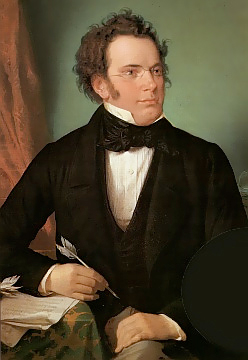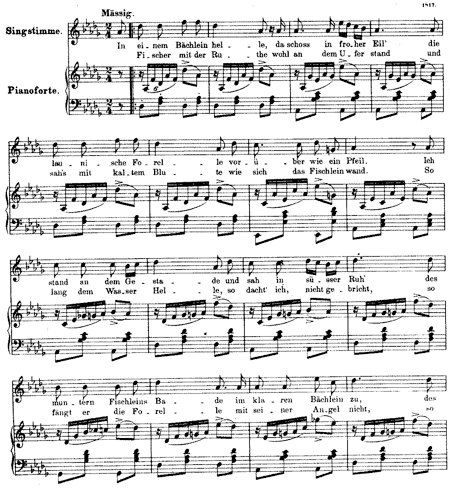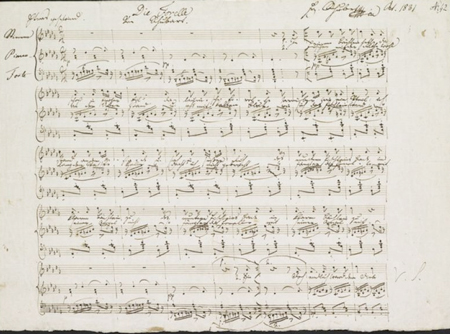by Neil McCalmont
Part of McCalmont’s List Series

Scoring: Piano, violin, viola, cello, and double bass
Era: Classical/Early Romantic
Length: c. 35 minutes
Will you recognize it? The fourth movement has achieved fame on its own, so perhaps
Recommended Recordings: Alfred Brendel and the Cleveland Quartet; or Emanuel Ax, Yo-Yo Ma, Pamela Frank, Edgar Meyer, and Rebecca Young
Composer: Franz Schubert (1797-1828). Like J. S. Bach, Schubert wrote over a thousand pieces of music and received almost zero recognition for his compositions during his lifetime. In fact, since his music was so rarely performed, Schubert often had to live through the generosity of his friends in order to survive, unfortunately fulfilling the stereotype of the “starving artist.” Many of his works come from the last decade of his life — he died when he was only 31. It was after his death that musicians such as Franz Liszt and Robert Schumann revived his works. Today, Schubert ranks as one of the greatest composers of the 19th century.
Because of his early death and lack of fame, there is little information about the man himself. He remained a bachelor, and most accounts of him come from his acquaintances. His musical style was significantly influenced by Mozart and Beethoven: rooted in Classical forms, filled with catchy melodies, and rich with dramatic content. Schubert is especially known for his Lieder, or songs for voice and piano, of which Dvorak wrote, “Schubert created a new epoch with [his] Lied… All other songwriters have followed in his footsteps.” One of the composer’s most moving songs is the famous Ave Maria.
The Piece: “The Trout” is a unique piece of chamber music: it breaks the four-movement standard with its five movements, departs from the instrumental norm of its genre by including a double bass, and is well known for its harmonic innovations, too. The work receives its nickname from the composer’s song “Die Forelle,” which in the fourth movement Schubert treats to several variations. The work is noteworthy for its captivating melodies and generally carefree feel.
Immediately following the first chord, you will hear a rising six-note figure in the piano, which is used in each movement but the third in order to unify them. Then the first theme begins, and Schubert’s tuneful melodies transition to contrasting emotional sections with fine craftsmanship — the second theme sneaks in as if through a back door.
The following Andante displays a delicate lyricism that reflects the stylistic shift to Romanticism during the early 1800s. It is split into two sections: the second is symmetrical to the first, but key changes give rise to more emotional tension.
Typically the third movement is a minuet, but Schubert instead inserts a different type of dance: a folk dance! This scherzo is filled with fun, and the middle section is the perfect contrast to the dance — simple, yet elegant.
The atypical fourth movement includes the theme and variations on “The Trout.” Schubert states the theme reservedly, and afterward takes us on a journey that is developed over the oh-so-catchy melody.
The finale, like the rest of the piece, is filled with hummable tunes and dramatic flow. Halfway through the movement, the piece sounds as if it has ended, but it begins again, this time shifting through various harmonic changes that culminate with a satisfying ending in the original key.
Personal Notes: This quintet is a ton of fun. It is a staple of the chamber repertoire, and it can be appreciated and loved by all. While the tunes are memorable, Schubert’s subtle genius also shines through in the accompanying material. This is music to whistle on a bright, sunny day.
Fun Facts:
- Schubert wrote the fourth movement at the suggestion of a cello-playing potential patron who loved his song “The Trout” so much he recommended that Schubert compose a theme and variations on it. Anxious for money, Schubert went right to work, but the cello part proved so difficult for his amateur patron that the score was left in a drawer unplayed for a decade.
- Schubert was a known workaholic — how else do you write so much music in so little time? One acquaintance recalled that he would go visit the composer, say hello, and Schubert would respond cheerfully, “Hello, how are you,” whereupon he would promptly get back to work, and the visitor was expected to leave.
- The poet Franz Grillparzer, a friend of Schubert’s, wrote the composer’s epitaph: “Here music has buried a treasure, but even fairer hopes.” Some, including renowned pianist Alfred Brendel, are upset at this epitaph since it implies that Schubert never reached full maturity as a composer.
Further Listening:
- Die Schöne Müllerin Song cycle by Schubert
- Piano Concerto No. 21 by Wolfgang Amadeus Mozart
- Symphony No. 1 by Ludwig van Beethoven
- “Emperor” String Quartet by Joseph Haydn
Published on ClevelandClassical.com July 6, 2016.
Click here for a printable copy of this article





